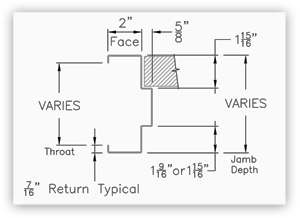SDI Now Offers Drawings
In early 2015, the Steel Door Institute sent an online survey asking how we could serve you better. The most common request was for SDI to provide drawings of door and frame details.

We’re pleased to introduce SDI’s new Drawings page with door and frame details in .pdf and .dwg formats. We plan on adding Revit Family drawings in 2016.
School Architects are Choosing Steel
Learn about the variety of steel doors that architects are specifying for their school projects.

New Installation & Troubleshooting Videos
Proper installation is essential to the longevity of doors and frames. Reference the videos below to ensure the products you specify perform to their potential.
Installation
- How to Install a Steel Door
- How to Install Frames in Steel Stud Construction
- How to Install Frames in Masonry Construction
Troubleshooting
- Fixing Improper Door Clearance
- Fixing Hinge Bind
When is Gasketing Required for Rated Openings?
Whether gasketing is required for rated openings depends on the code in effect when the project is issued a permit, and where the particular door opening is located—for instance, in a smoke partition or smoke barrier. In general, doors required to comply with NFPA 105 – Standard for Smoke Door Assemblies and Other opening Protectives require gasketing.
In the International Building Code (IBC), NFPA 101 – The Life Safety Code, and NFPA 105 – Standard for Smoke Door Assemblies and Other Opening Protectives, you will find reference to specific door locations where air infiltration must be limited, driving the need for smoke gasketing at those openings.
The codes and standards don’t state a specific requirement for smoke gasketing, so the key is to reference UL 1784 – Standard for Air Leakage Tests of Door Assemblies. This standard does not mandate gasketing, or even an allowable limit for air flow, but is used as the test standard to measure the amount of air passing through the opening.
The maximum amount of air infiltration is established by the code or standard, along with the reference to UL 1784. In the International Building Code (IBC), NFPA 101 – The Life Safety Code, and NFPA 105 – Standard for Smoke Door Assemblies and Other Opening Protectives, you will find reference to specific door locations where air infiltration must be limited, driving the need for smoke gasketing at those openings. Because NFPA 105 includes a limitation on air leakage, a model code reference for doors to comply with NFPA 105 is typically interpreted as a requirement for gasketing.
NFPA 101 (2015) requires openings to be smoke-leakage rated in the following locations:
- New fire door assemblies serving an area of refuge (7.2.12.3.4.1)
- Doors opening into vestibules provided as part of a smokeproof enclosure (7.2.3.4)
- New doors in horizontal exits (7.2.4.3.9)
- Occupant evacuation shaft system elevator lobby doors except as excluded by NFPA 101 (7.14.9.7)
The IBC (2015) requires limited air infiltration when tested to the UL 1784 standard for doors in these locations:
- Smoke barrier penetrations in underground buildings (405.4.2) and Group I-3 facilities (408.6)
- Fire door assemblies in corridors and smoke barriers (716.5.3.1)
- Smokeproof enclosure vestibule doors where mechanical ventilation is used (909.20.4.1)
- Elevator hoistway doors when hoistway protection is required (3006.3(3))
- Fire service access elevator lobby doors except as excluded by the IBC (3007.6.3)
- Occupant evacuation elevator lobby doors except as excluded by the IBC (3008.6.3)
There may be other locations where smoke gasketing is needed, for example, to help maintain stairwell pressurization. Reference the code that has been adopted in the project’s jurisdiction to determine the applicable requirements. When in doubt, consult with the Authority Having Jurisdiction who is responsible for enforcing the provisions of the code.
